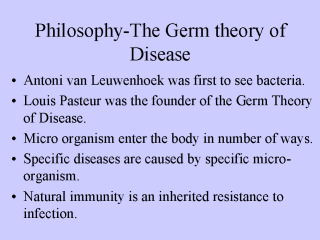| front |1 |2 |3 |4 |5 |6 |7 |8 |9 |10 |11 |12 |13 |14 |15 |16 |17 |18 |19 |20 |21 |22 |23 |24 |25 |26 |review |
 |
Probably the
first person to see the bacteria under the microscope was Antoni Leuwenhoek of Delft,
Holland , 1683. But the credit for the discovery of the relationship of bacteria to
disease was given to Louis Pasteur, and known as the founder of what came to be known as
Germ Theory of Disease. The following are the chief points upon which the Germ Theory was
founded. Micro-organisms enter the body in number of ways-via nose and mouth (e.g diphtheria); by drinking water or milk (e.g typhoid fever); by infected food (e.g choleras); through the skin (e.g tetanus), by insects (e.g Malaria) and so on. Bacteria create disease by producing toxins (poisons). Specific diseases are caused by specific microorganism: e.g pneumococus bacterium has an affinity to lung tissue and believed to be cause of pneumonia, the polio myelitis virus tend to infect the particular cells of the spinal cord and so causes paralysis. On the other hand certain bacteria was regarded as non-specific, such as streptococci (rheumatic fever). While staphylococci were responsible of septicaemia and other conditions. The Germ theory has to include a theory of immunity' in fact without this the whole theory of bacterial infection would be quite untenable. Pasteur stated that disease is a germ and a germ is a disease and having also stated that germs are universally present, unless animals, including man, possessed some form of immunity, the whole of animal life would have been wiped out thousands of years ago. Natural immunity is an inherited resistance to infection. For example dogs are immune to anthrax, rats for diphtheria, animals are immune to syphilis, even in the same species there are relative degrees of natural immunity e.g tropical natives are much less liable to malaria than white visitors. |
| front |1 |2 |3 |4 |5 |6 |7 |8 |9 |10 |11 |12 |13 |14 |15 |16 |17 |18 |19 |20 |21 |22 |23 |24 |25 |26 |review |